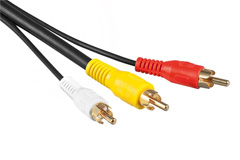Composite video is the most common and simplest image signal form and almost all equipment supports this transmission type. Composite is not the optimal connection type, as both S-Video, RGB, Component and Digital Video offer better contrast, sharpness and more colour shades. The beauty of composite video is that it can be fed in just one video cable and does not need a multi-core cable like S-Video, Component and RGB.
For transmission of composite video signals, as for all other analogue video signals, use coaxial cables with an impedance of 75 ohms for optimum quality. If the cable does not have the correct impedance, you will often get shadows in the image. Composite cables do not transmit audio signals, a separate cable is normally routed for this. Composite signal can run at a resolution of up to 480i (NTSC) or 576i (PAL).
Composite video cables are normally used for connecting regular VHS video players which by definition do not support other video signal types. A common misconception is that all devices with a SCART connector support S-Video and RGB. However, this is not the case for regular non-SuperVHS machines and when coupling with an S-Video cable, you will get a black/white picture.
